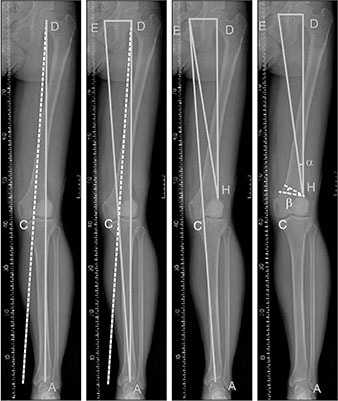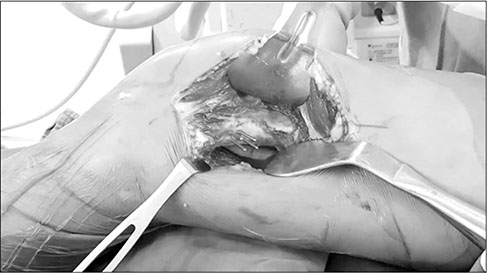J Korean Orthop Assoc.
2018 Aug;53(4):301-306. 10.4055/jkoa.2018.53.4.301.
Surgical Technique for Distal Femur Varization Osteotomy
- Affiliations
-
- 1Department of Orthopedic Surgery, Sahmyook Medical Center, Seoul, Korea. hyw0202@hanmail.net
- 2Department of Orthopedic Surgery, Inje University Ilsan Paik Hospital, Goyang, Korea.
- KMID: 2419465
- DOI: http://doi.org/10.4055/jkoa.2018.53.4.301
Abstract
- A closing wedge distal femoral osteotomy is a procedure to reduce pain and delay the progression of degenerative arthritis of knee by moving the weight bearing line from the lateral compartment to the medial side while preserving the knee joint. Age, weight bearing line, and the degree of arthritis are the essential factors to be considered at the time of surgery. The indications for distal femoral osteotomy are as follows. All patients are aged less than 65 years old, normal medial compartment of the knee with normal patello femoral joint, valgus deformity with lateral degenerative arthritis, younger patients with lateral osteochondritis, congenital osteochondrosis, and recurrent patellar dislocation with genu valgum. The distal femoral osteotomy provides the advantages of rapid pain reduction and short rehabilitation in young and active patients and patients who are subjected to heavy loads on the knee.
MeSH Terms
Figure
Reference
-
1. Healy WL, Anglen JO, Wasilewski SA, Krackow KA. Distal femoral varus osteotomy. J Bone Joint Surg Am. 1988; 70:102–109.
Article2. Thein R, Bronak S, Thein R, Haviv B. Distal femoral osteotomy for valgus arthritic knees. J Orthop Sci. 2012; 17:745–749.
Article3. Gross AE, Hutchison CR. Realignment osteotomy of the knee—Part 1: distal femoral varus osteotomy for osteoarthritis of the Valgus knee. Oper Tech Sports Med. 2000; 8:122–126.
Article4. Aglietti P, Menchetti PP. Distal femoral varus osteotomy in the valgus osteoarthritic knee. Am J Knee Surg. 2000; 13:89–95.5. Elahi S, Cahue S, Felson DT, Engelman L, Sharma L. The association between varus-valgus alignment and patellofemoral osteoarthritis. Arthritis Rheum. 2000; 43:1874–1880.
Article6. Shen HC, Chao KH, Huang GS, Pan RY, Lee CH. Combined proximal and distal realignment procedures to treat the habitual dislocation of the patella in adults. Am J Sports Med. 2007; 35:2101–2108.
Article7. Lobenhoffer P, Van Heerwaarden RJ, Staubli AE, Jakob RP. Osteotomies around the knee: indications-planning-surgical techniques using plate fixators. New York: AO Foundation, Thieme;2008. p. 150–152.8. Finkelstein JA, Gross AE, Davis A. Varus osteotomy of the distal part of the femur. A survivorship analysis. J Bone Joint Surg Am. 1996; 78:1348–1352.
Article9. Puddu G, Cipolla M, Cerullo G, Franco V, Giannì E. Which osteotomy for a valgus knee? Int Orthop. 2010; 34:239–247.
Article10. Hunter DJ, Sharma L, Skaife T. Alignment and osteoarthritis of the knee. J Bone Joint Surg Am. 2009; 91:Suppl 1. 85–89.
Article11. Wang JW, Hsu CC. Distal femoral varus osteotomy for osteoarthritis of the knee Surgical technique. J Bone Joint Surg Am. 2006; 88:Suppl 1 Pt 1. 100–108.12. Backstein D, Morag G, Hanna S, Safir O, Gross A. Long-term follow-up of distal femoral varus osteotomy of the knee. J Arthroplasty. 2007; 22:S2–S6.
Article13. Sternheim A, Garbedian S, Backstein D. Distal femoral varus osteotomy: unloading the lateral compartment: long-term follow-up of 45 medial closing wedge osteotomies. Orthopedics. 2011; 34:e488–e490.
Article14. Nelson CL, Saleh KJ, Kassim RA, et al. Total knee arthroplasty after varus osteotomy of the distal part of the femur. J Bone Joint Surg Am. 2003; 85:1062–1065.
Article
- Full Text Links
- Actions
-
Cited
- CITED
-
- Close
- Share
- Similar articles
-
- Distal Femoral Varization Osteotomy
- Deformity Correction by Femoral Supracondylar Dome Osteotomy with Retrograde Intramedullary Nailing in Varus Deformity of the Distal Femur after Pathologic Fracture of Giant Cell Tumor
- Component Size Matched Extension Gap Osteotomy for TKRA: A New Concept in Knee Osteotomy for TKRA
- Osteotomy around the Knee: Indication and Preoperative Planning
- Surgical Treatment of Habitual Patella Dislocation with Genu Valgum








